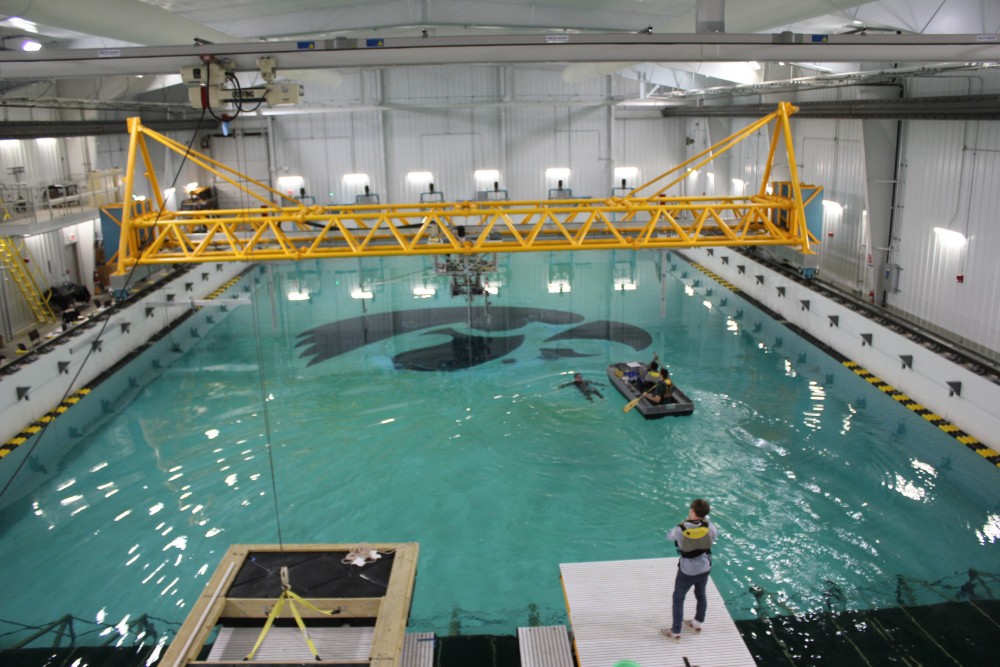U.S. DOE Wave Energy Prize Comes to IIHR
January 29, 2016
by Shianne Fisher

CalWave is one of several organizations testing wave energy technologies at the IIHR Wave Basin. The teams are competing for a U.S. Department of Energy prize; IIHR has been selected as one of five sites nationwide to serve as a test facility.
More than a thousand miles from any maritime coast, the University of Iowa has been selected as a test facility for wave energy convertor (WEC) technologies that could change the way the world accomplishes renewable energy goals.
Fred Stern, researcher at IIHR—Hydroscience & Engineering and leader of the institute’s ship hydrodynamics group, received the funding of $181,424 from global engineering firm Ricardo PLC for the testing. The University of Iowa is one of five institutions chosen as test sites for small-scale models of the WEC devices. The others are Oregon State University, Stevens Institute of Technology, the University of Maine, and the University of Michigan.
The testing is just one portion of the U.S. Department of Energy’s Wave Energy Prize competition, launched this year to stimulate development of innovative WEC technologies. Currently, 20 teams are competing to achieve finalist-status and test their devices in the Naval Surface Warfare Centre’s Maneuvering and Seakeeping (MASK) basin at Carderock in Potomac, Md. First, however, they must pass proof of concept small-scale testing, and many will aim to do so at the IIHR Wave Basin, a state-of-the-art facility completed in 2010 that accommodates free-model testing in an open body of water.
“We’ve tested a variety of vessels over the years, but this is a first,” says Stern. “I think the contestants will be pleased with the types of results they can get at our facility.” The 40x20x3-meter basin can test ships—or in this case wave energy converters—under many different real-world conditions, making it a valuable tool is assessing whether the WEC devices will be able to prove their worth on the open ocean. “Imagine model ships in Central Park,” says Stern, “just less picturesque.”
One semi-finalist, Sea Potential (Bristol, R.I.), tested its device, known as DUO, at IIHR late last year. Stern says the testing was successful and gave the team valuable feedback to prepare for the next stage. The team aims to use the Wave Energy Prize competition as a step toward deployment of DUO demonstration projects and wave farms off the coasts of North America.
If successful, Sea Potential could be one of up to 10 finalists and alternates announced in March 2016, once the 1:50 scale testing is complete. The highest-ranked team after the 1:20 scale testing at Carderock will receive seed funding of $1.5 million. Second place will be awarded $500K and third place $250K.
Stern says he has enjoyed having teams use the wave basin for testing. “It’s not every day the ship hydro team is involved in this kind of upcoming technology,” he says. In early January, team CalWave (Berkeley, Calif.) was testing at the Wave Basin, and team Waveswing America (Sacramento, Calif.) finished up at the end of the month.
Stern notes that this has been a team effort among his ship hydro colleagues, including researchers Yugo Sanada and Hyunse Yoon, as well as postdoctoral research scholar Sung-Hwan Yoon. IIHR shop support staff members Troy Lyons, Director of Engineering Services; Alan McCarville, Engineering Coordinator; and Brandon Barquist, Shop Manager, have also assisted with the testing.
The DOE created a consortium, led by Ricardo PLC, to administer the prize. Other members of the consortium include JZ Consulting and Polaris Communications and the Prize Administration Team (PAT), with specialist technical support provided by Sandia National Laboratory (SNL) and the National Renewable Energy Laboratory (NREL).
Learn more about the DOE Wave Energy Prize at waveenergyprize.org and on Twitter @WaveEnergyPrize.









